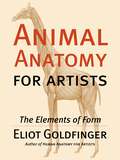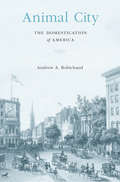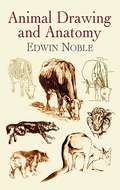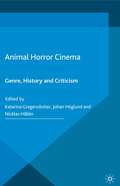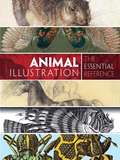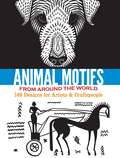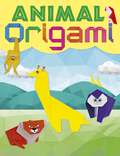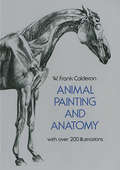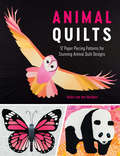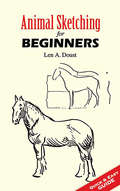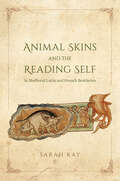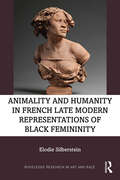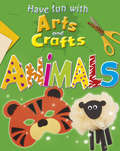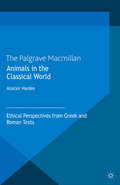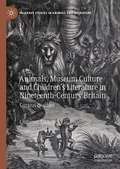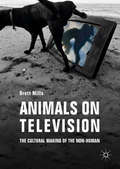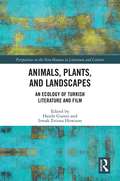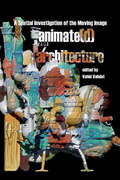- Table View
- List View
Animal Anatomy For Artists (PDF): The Elements Of Form
by Eliot GoldfingerFrom the author of the classic Human Anatomy for Artists comes this user-friendly reference guide featuring over five hundred original drawings and over seventy photographs. Designed for painters, sculptors, and illustrators who use animal imagery in their work, Animal Anatomy for Artists offers thorough, in-depth information about the most commonly depicted animals, presented in a logical and easily understood format for artists--whether beginner or accomplished professional. The book focuses on the forms created by muscles and bones, giving artists a crucial three-dimensional understanding of the final, complex outer surface of the animal. Goldfinger not only covers the anatomy of the more common animals, such as the horse, dog, cat, cow, pig, squirrel, and rabbit, but also the anatomy of numerous wild species, including the lion, giraffe, deer, hippopotamus, rhinoceros, elephant, gorilla, sea lion, and bear. Included are drawings of skeletons and how they move at the joints, individual muscles showing their attachments on the skeleton, muscles of the entire animal, cross sections, photographs of live animals, and silhouettes of related animals comparing their shapes and proportions. He offers a new and innovative section on the basic body plan of four-legged animals, giving the reader a crucial conceptual understanding of overall animal structure to which the details of individual animals can then be applied. The chapter on birds covers the skeleton, muscles and feather patterns. The appendix presents photographs of skulls with magnificent horns and antlers and a section on major surface veins. Incredibly thorough, packed with essential information, Animal Anatomy for Artists is a definitive reference work, an essential book for everyone who depicts animals in their art.
Animal Biometrics: Techniques and Applications
by Santosh Kumar Sanjay Kumar Singh Rishav Singh Amit Kumar SinghThis book presents state-of-the-art methodologies and a comprehensive introduction to the recognition and representation of species and individual animals based on their physiological and phenotypic appearances, biometric characteristics, and morphological image patterns. It provides in-depth coverage of this emerging area, with an emphasis on the design and analysis techniques used in visual animal biometrics-based recognition systems.The book offers a comprehensive introduction to visual animal biometrics, addressing a range of recent advances and practices like sensing, feature extraction, feature selection and representation, matching, indexing of feature sets, and animal biometrics-based multimodal systems. It provides authoritative information on all the major concepts, as well as highly specific topics, e.g. the identification of cattle based on their muzzle point image pattern and face images to prevent false insurance claims, or the monitoring and registration of animals based on their biometric features. As such, the book provides a sound platform for understanding the Visual Animal Biometrics paradigm, a vital catalyst for researchers in the field, and a valuable guide for professionals. In addition, it can help both private and public organizations adapt and enhance their classical animal recognition systems.
Animal City: The Domestication of America
by Andrew A. RobichaudAmerican urbanites once lived alongside livestock and beasts of burden. But as cities grew, human–animal relationships changed. The city became a place for pets, not slaughterhouses or working animals. Andrew Robichaud traces the far-reaching consequences of this shift—for urban landscapes, animal- and child-welfare laws, and environmental justice.
Animal Drawing and Anatomy
by Edwin Noble"No artist, designer, or craftsman can be regarded as fully equipped without a knowledge of natural forms," asserts this instructive volume. "All forms of life offer rich material for design, whether realistic or conventional," it notes, adding that studies from life "of the human figure, the forms of all animals and birds, and of the inhabitants of the waters, and of plants, must precede mastery of the art of design." With this profusely illustrated guide, beginners can learn the fundamentals of animal drawing, and more experienced artists can find tips that will assist them in refining their skills. Written and illustrated by a distinguished artist and art instructor of the early twentieth century, this volume features valuable insights into reproducing accurate images of horses, cows, dogs, sheep, birds, and wild animals. The explanatory text, highlighted by 233 drawings, offers advice not only on depicting musculature, hair, feathers, and other obvious physical features, but also on such essentials as action, pose, proportions, and character.
Animal Horror Cinema: Genre, History and Criticism
by Johan Höglund Katarina Gregersdotter Nicklas HållénThis first full-length scholarly study about animal horror cinema defines the popular subgenre and describes its origin and history in the West. The chapters explore a variety of animal horror films from a number of different perspectives. This is an indispensable study for students and scholars of cinema, horror and animal studies.
Animal Illustration: The Essential Reference
by Carol Belanger GraftonComprehensive and entertaining, this volume comprises the greatest works in animal illustration from the Middle Ages through the twentieth century. The chronological presentation of hundreds of black-and-white and color images begins with a medieval illuminated manuscript by the Limbourg brothers and the Renaissance works of Albrecht Dürer and other artists from the first centuries of printing. Subsequent illustrations include the seventeenth-century real and imaginary animals of Matthäus Merian and the unique eighteenth-century compilations of Albertus Seba. Nineteenth-century images are drawn from sources as diverse as J. G. Heck's Bilder Atlas; the prints of Georges Baron Cuvier; William Jardine's 40-volume Naturalist's Library; bird illustrations by John James Audubon, Alexander Wilson, Edward Lear, and many others; extraordinary butterfly and insect images by E. A. Seguy, as well as animal illustrations from Victorian chromolithograph die cuts. The exquisite Edwardian bestiary of the Detmold brothers brings the collection into the twentieth century, and ends with the imagery of contemporary dinosaur artist James Gurney.Detailed bibliographical information concerning every source—including biographical details of each artist—makes this collection a vital reference tool as well as a splendid resource of outstanding animal illustrations. Students of graphic art and illustration, as well as graphic designers and advertising professionals, will prize this treasury of material from many rare historic sources.
Animal Motifs from Around the World: 140 Designs for Artists & Craftspeople
by Doris RosenthalDrawn from the ancient art and artifacts of an international array of museum collections, this spectacular volume offers a unique selection of unusual animal motifs from Prussia, Egypt, Persia, China, Germany, Sweden, and other areas. The edgy designs possess a timeless appeal that makes them especially attractive to contemporary designers, tattoo artists, crafters, and others.
Animal Origami: A step-by-step guide to creating a whole world of paper models!
by Belinda Webster Joe FullmanDiscover how to turn a simple square of paper into something really wild!From a lion or a tiger to a polar bear or a parrot, this book is packed with amazing animal models for you to create. The fantastic photos and clear, step-by-step instructions make each project really easy to master and lots of fun to fold.
Animal Painting and Anatomy
by W. Frank CalderonDrawing is "the very essence of all pictorial art," and this book approaches the challenging art of animal painting from the point of view of accurate representation of animal subjects on canvas. Combining useful information on important anatomical features with direction on how to handle the subjects and how to express their forms and postures, the author has produced a complete, inexpensive, at-home course in animal painting and anatomy.All aspects of animal drawing and painting are covered: drawing from life; anatomy in relation to drawing (not surgical anatomy, but a precise knowledge of the visible structure and movements of animals); characteristic movements of animals and suggestions on how to capture them in your picture; composition (design, restraint, rhythm, balance of light and shade, relative scale of animals and landscape, foregrounds); painting and color. 36 illustrations, mostly sketches by the author, depict horses, pigs, cows, dogs, and other animals in various life positions and movements. A long, detailed discussion of the anatomy of animals completes the book. Here Mr. Calderon describes all the structures of animals that are of significance to the artist: the vertebral skeleton, the bones and muscles of the head, the muscles of the vertebral skeleton, the fore-limb and its muscles, the muscles attaching the shoulder blade to the trunk, and the bones and muscles of the hind limb. 208 drawings accompany these discussions and show you how anatomy is related to surface contours and techniques of shading.
Animal Quilts: 12 Paper Piecing Patterns for Stunning Animal Quilt Designs
by Juliet van der HeijdenCreate incredible quilts for your home with this collection of foundation paper-pieced quilt patterns featuring 12 different animals. Learn how to create realistic representations of your favourite animals and birds in stunning paper-pieced quilt blocks. This unique collection of 12 contemporary quilt patterns includes a tiger, butterfly, swan, owl, peacock and polar bear as well as many more. There are instructions to show how to resize the quilt blocks if you want to make them larger, as well as instructions for how to add borders to increase the size of the overall quilt. Author and foundation paper piecing expert, Juliet van der Heijden, explains how your fabric choice can really alter the overall effect of the quilt patterns to create very different results, and she encourages you to have fun and adapt the quilt patterns through your own choice of fabrics. There are step-by-step instructions showing Juliet's foundation paper-piecing techniques and all the pattern pieces are available via a PDF download.
Animal Sketching for Beginners
by Len A. DoustThis handy manual provides the confidence, insight, and guidance to help any sketcher create realistic animal drawings. With the help of the author's thirty-one clearly detailed drawings, this basic how-to-guide:* illustrates major attributes shared by many animals* shows how simple shapes can create complex drawings* functions as a valuable anatomy referenceA source of inspiration for artists at all levels, this book will be especially helpful to beginning art students.
Animal Skins and the Reading Self in Medieval Latin and French Bestiaries
by Sarah KayJust like we do today, people in medieval times struggled with the concept of human exceptionalism and the significance of other creatures. Nowhere is this more apparent than in the medieval bestiary. Sarah Kay’s exploration of French and Latin bestiaries offers fresh insight into how this prominent genre challenged the boundary between its human readers and other animals. Bestiaries present accounts of animals whose fantastic behaviors should be imitated or avoided, depending on the given trait. In a highly original argument, Kay suggests that the association of beasts with books is here both literal and material, as nearly all surviving bestiaries are copied on parchment made of animal skin, which also resembles human skin. Using a rich array of examples, she shows how the content and materiality of bestiaries are linked due to the continual references in the texts to the skins of other animals, as well as the ways in which the pages themselves repeatedly—and at times, it would seem, deliberately—intervene in the reading process. A vital contribution to animal studies and medieval manuscript studies, this book sheds new light on the European bestiary and its profound power to shape readers’ own identities.
Animal Skins and the Reading Self in Medieval Latin and French Bestiaries
by Sarah KayJust like we do today, people in medieval times struggled with the concept of human exceptionalism and the significance of other creatures. Nowhere is this more apparent than in the medieval bestiary. Sarah Kay’s exploration of French and Latin bestiaries offers fresh insight into how this prominent genre challenged the boundary between its human readers and other animals. Bestiaries present accounts of animals whose fantastic behaviors should be imitated or avoided, depending on the given trait. In a highly original argument, Kay suggests that the association of beasts with books is here both literal and material, as nearly all surviving bestiaries are copied on parchment made of animal skin, which also resembles human skin. Using a rich array of examples, she shows how the content and materiality of bestiaries are linked due to the continual references in the texts to the skins of other animals, as well as the ways in which the pages themselves repeatedly—and at times, it would seem, deliberately—intervene in the reading process. A vital contribution to animal studies and medieval manuscript studies, this book sheds new light on the European bestiary and its profound power to shape readers’ own identities.
Animal Skins and the Reading Self in Medieval Latin and French Bestiaries
by Sarah KayJust like we do today, people in medieval times struggled with the concept of human exceptionalism and the significance of other creatures. Nowhere is this more apparent than in the medieval bestiary. Sarah Kay’s exploration of French and Latin bestiaries offers fresh insight into how this prominent genre challenged the boundary between its human readers and other animals. Bestiaries present accounts of animals whose fantastic behaviors should be imitated or avoided, depending on the given trait. In a highly original argument, Kay suggests that the association of beasts with books is here both literal and material, as nearly all surviving bestiaries are copied on parchment made of animal skin, which also resembles human skin. Using a rich array of examples, she shows how the content and materiality of bestiaries are linked due to the continual references in the texts to the skins of other animals, as well as the ways in which the pages themselves repeatedly—and at times, it would seem, deliberately—intervene in the reading process. A vital contribution to animal studies and medieval manuscript studies, this book sheds new light on the European bestiary and its profound power to shape readers’ own identities.
Animal Skins and the Reading Self in Medieval Latin and French Bestiaries
by Sarah KayJust like we do today, people in medieval times struggled with the concept of human exceptionalism and the significance of other creatures. Nowhere is this more apparent than in the medieval bestiary. Sarah Kay’s exploration of French and Latin bestiaries offers fresh insight into how this prominent genre challenged the boundary between its human readers and other animals. Bestiaries present accounts of animals whose fantastic behaviors should be imitated or avoided, depending on the given trait. In a highly original argument, Kay suggests that the association of beasts with books is here both literal and material, as nearly all surviving bestiaries are copied on parchment made of animal skin, which also resembles human skin. Using a rich array of examples, she shows how the content and materiality of bestiaries are linked due to the continual references in the texts to the skins of other animals, as well as the ways in which the pages themselves repeatedly—and at times, it would seem, deliberately—intervene in the reading process. A vital contribution to animal studies and medieval manuscript studies, this book sheds new light on the European bestiary and its profound power to shape readers’ own identities.
Animality and Humanity in French Late Modern Representations of Black Femininity (Routledge Research in Art and Race)
by Elodie SilbersteinThis volume examines the evolution of the depictions of black femininity in French visual culture as a prism through which to understand the Global North’s destructive relationship with the natural world. Drawing on a broad spectrum of archives extending back to the late 18th century – paintings, fashion plates, prints, photographs, and films – this study traces the intricate ways a patriarchal imperialism and a global capitalism have paired black women with the realm of nature to justify the exploitation both of people and of ecosystems. These dehumanizing and speciesist strategies of subjugation have perpetuated interlocking patterns of social injustice and environmental depletion that constitute the most salient challenges facing humankind today. Through a novel approach that merges visual studies, critical race theory, and animal studies, this interdisciplinary investigation historicizes the evolution of the boundaries between human and non-human animals during the modern period. The book will be of interest to scholars working in art history, visual studies, critical race theory, colonial and post-colonial studies, animal studies, and French studies.
Animality and Humanity in French Late Modern Representations of Black Femininity (Routledge Research in Art and Race)
by Elodie SilbersteinThis volume examines the evolution of the depictions of black femininity in French visual culture as a prism through which to understand the Global North’s destructive relationship with the natural world. Drawing on a broad spectrum of archives extending back to the late 18th century – paintings, fashion plates, prints, photographs, and films – this study traces the intricate ways a patriarchal imperialism and a global capitalism have paired black women with the realm of nature to justify the exploitation both of people and of ecosystems. These dehumanizing and speciesist strategies of subjugation have perpetuated interlocking patterns of social injustice and environmental depletion that constitute the most salient challenges facing humankind today. Through a novel approach that merges visual studies, critical race theory, and animal studies, this interdisciplinary investigation historicizes the evolution of the boundaries between human and non-human animals during the modern period. The book will be of interest to scholars working in art history, visual studies, critical race theory, colonial and post-colonial studies, animal studies, and French studies.
Animals (Have Fun with Arts and Crafts #5)
by Rita StoreyFun and engaging arts and crafts ideas centring on children's interests.
Animals in the Classical World: Ethical Perspectives from Greek and Roman Texts (The Palgrave Macmillan Animal Ethics Series)
by A. HardenThis sourcebook presents nearly 200 specially-translated Greek and Roman texts from Homer to Plutarch, revealing the place of the animal in the moral consciousness of the Classical era. Philosophical, historical, dramatic and poetic texts explore how animals were regarded in all aspects of ancient life, from philosophy to farming.
Animals, Museum Culture and Children’s Literature in Nineteenth-Century Britain: Curious Beasties (Palgrave Studies in Animals and Literature)
by Laurence TalairachAnimals, Museum Culture and Children’s Literature in Nineteenth-Century Britain: Curious Beasties explores the relationship between the zoological and palaeontological specimens brought back from around the world in the long nineteenth century—be they alive, stuffed or fossilised—and the development of children’s literature at this time. Children’s literature emerged as dizzying numbers of new species flooded into Britain with scientific expeditions, from giraffes and hippopotami to kangaroos, wombats, platypuses or sloths. As the book argues, late Georgian, Victorian and Edwardian children’s writers took part in the urge for mass education and presented the world and its curious creatures to children, often borrowing from their museum culture and its objects to map out that world. This original exploration illuminates how children’s literature dealt with the new ordering of the world, offering a unique viewpoint on the construction of science in the long nineteenth century.
Animals on Television: The Cultural Making of the Non-Human
by Brett MillsThis book is the first in-depth study of the representation of animals on television. It explores the variety of ways animals are represented in audio-visual media, including wildlife documentaries and children’s animated series, and the consequences these representations have for those species. Brett Mills discusses key ideas and approaches essential for thinking about animals drawing on relevant debates in philosophy, politics, gender studies, humanism and posthumanism, and ethics. The chapters examine different animal representations, focusing on zoos, pets, wildlife and meat. They present case studies, including discussions of Peppa Pig, The Hunt and The Dog Whisperer. This book will be of interest to readers exploring media studies, contemporary television, animal studies, and debates about representation.
Animals, Plants, and Landscapes: An Ecology of Turkish Literature and Film (Perspectives on the Non-Human in Literature and Culture)
by Hande Gurses Irmak Ertuna HowisonThe landscape of Turkey, with its trees and animals inspires narratives of survival, struggle and escape. Animals, Plants, and Landscapes: An Ecology of Turkish Literature and Film, will be the first major study to offer fresh theoretical insight into this landscape, by offering a collection of analyses of key texts of Turkish literature and cinema. Through discussion of both classical and contemporary works, this volume, paves the way for the formation of a ecocritical canon in Turkish literature and the rise of certain themes that are unique to Turkish experience. Snakes, fishermen and fish who catch men, porcupines contemplating on human agency, dogs exiled on an island and men who put dogs to fights, goat herders and windy steppes of Anatolia are all agents in a territory that constantly shifts. The essays included in this volume demonstrate the ways in which the crystallized relations between human and non-human form, break, and transform.
Animals, Plants, and Landscapes: An Ecology of Turkish Literature and Film (Perspectives on the Non-Human in Literature and Culture)
by Hande Gurses Irmak Ertuna HowisonThe landscape of Turkey, with its trees and animals inspires narratives of survival, struggle and escape. Animals, Plants, and Landscapes: An Ecology of Turkish Literature and Film, will be the first major study to offer fresh theoretical insight into this landscape, by offering a collection of analyses of key texts of Turkish literature and cinema. Through discussion of both classical and contemporary works, this volume, paves the way for the formation of a ecocritical canon in Turkish literature and the rise of certain themes that are unique to Turkish experience. Snakes, fishermen and fish who catch men, porcupines contemplating on human agency, dogs exiled on an island and men who put dogs to fights, goat herders and windy steppes of Anatolia are all agents in a territory that constantly shifts. The essays included in this volume demonstrate the ways in which the crystallized relations between human and non-human form, break, and transform.
Animate(d) Architecture: A Spatial Investigation of the Moving Image
by Vahid VahdatAt their peak, architectural marvels such as the Sagrada Família, the Tower of London, the Mosque–Cathedral of Córdoba, and the Eiffel tower, had a combined annual visit of almost 16.4 million people. The animated icebound castle in Disney’s (2019) Frozen had 116.4 million views, from one single YouTube trailer, in less than 24 hours. The spaces of such massively consumed animation have for generations informed the architectural imagination of people across the globe and from very early in their lives. Yet, not only have the architectural disciplines remained rather absent in the design of these massively consumed spaces, architectural theory has likewise failed to articulate a framework to approach the architecture of animation. To address this void, this book offers an interdisciplinary approach to survey the role of space in animation, including in creating humorous moments in early cartoon shorts, generating action and suspense in Japanese anime, and even stimulating erotic pleasure in pornographic Hentai. Exploring the imagined architecture of animation, from early motion picture to digital animation and from computer graphics to game engines, offers an analytical frame to reconceptualize space.
Animate(d) Architecture: A Spatial Investigation of the Moving Image
At their peak, architectural marvels such as the Sagrada Família, the Tower of London, the Mosque–Cathedral of Córdoba, and the Eiffel tower, had a combined annual visit of almost 16.4 million people. The animated icebound castle in Disney’s (2019) Frozen had 116.4 million views, from one single YouTube trailer, in less than 24 hours. The spaces of such massively consumed animation have for generations informed the architectural imagination of people across the globe and from very early in their lives. Yet, not only have the architectural disciplines remained rather absent in the design of these massively consumed spaces, architectural theory has likewise failed to articulate a framework to approach the architecture of animation. To address this void, this book offers an interdisciplinary approach to survey the role of space in animation, including in creating humorous moments in early cartoon shorts, generating action and suspense in Japanese anime, and even stimulating erotic pleasure in pornographic Hentai. Exploring the imagined architecture of animation, from early motion picture to digital animation and from computer graphics to game engines, offers an analytical frame to reconceptualize space.
